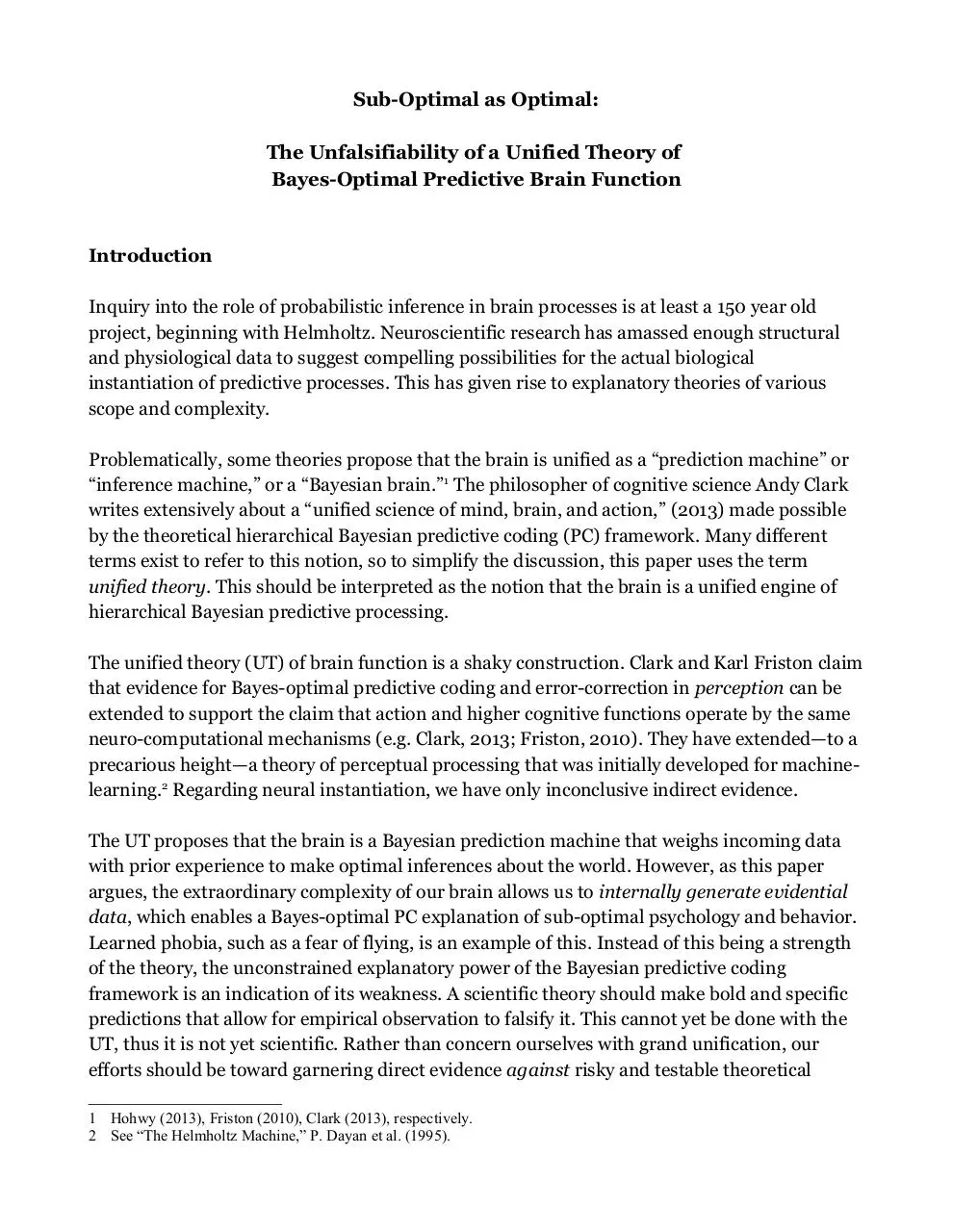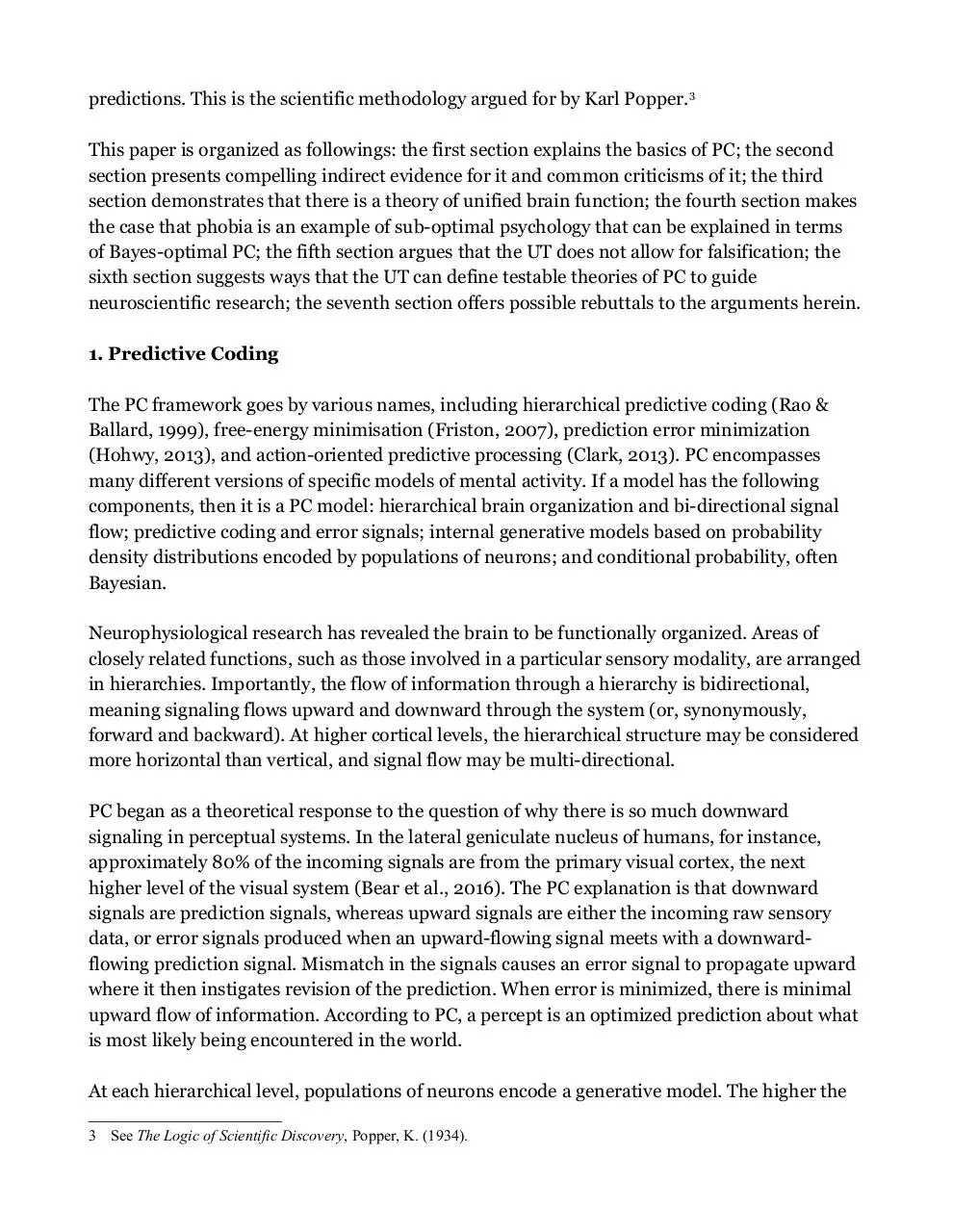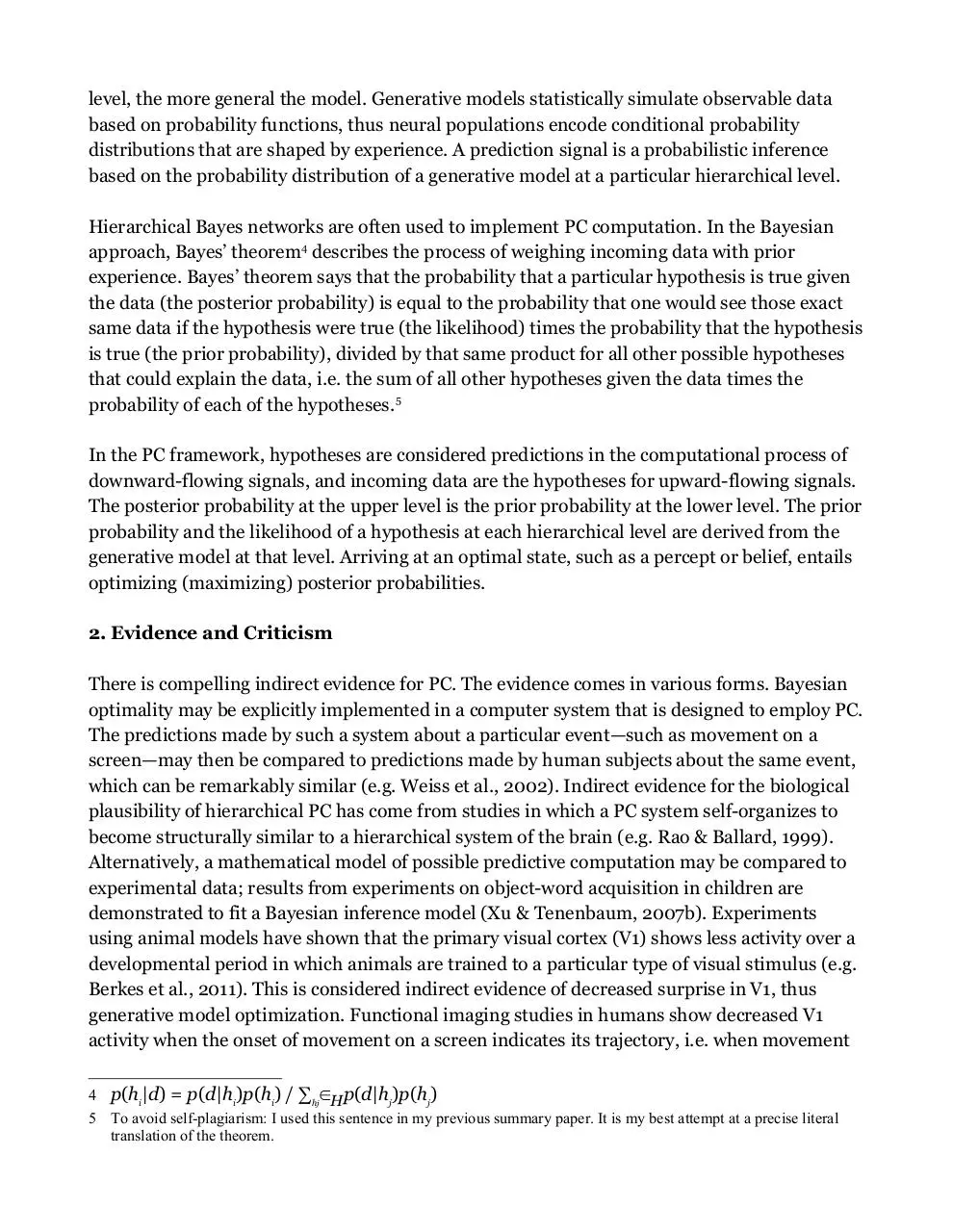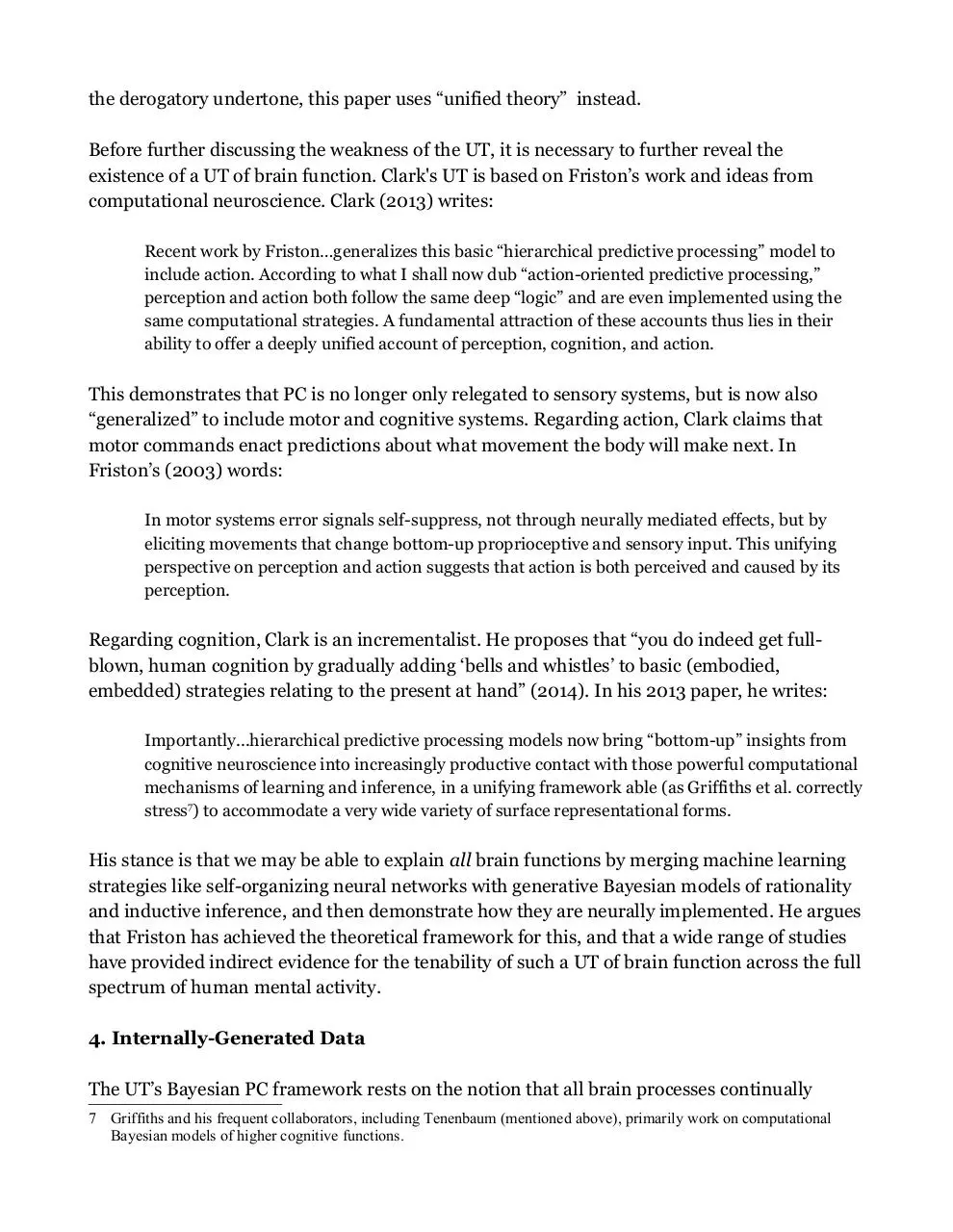Sub Optimal as Optimal (PDF)
File information
This PDF 1.4 document has been generated by Writer / OpenOffice 4.1.0, and has been sent on pdf-archive.com on 15/09/2016 at 08:37, from IP address 71.222.x.x.
The current document download page has been viewed 573 times.
File size: 160.52 KB (14 pages).
Privacy: public file





File preview
Sub-Optimal as Optimal:
The Unfalsifiability of a Unified Theory of
Bayes-Optimal Predictive Brain Function
Introduction
Inquiry into the role of probabilistic inference in brain processes is at least a 150 year old
project, beginning with Helmholtz. Neuroscientific research has amassed enough structural
and physiological data to suggest compelling possibilities for the actual biological
instantiation of predictive processes. This has given rise to explanatory theories of various
scope and complexity.
Problematically, some theories propose that the brain is unified as a “prediction machine” or
“inference machine,” or a “Bayesian brain.”1 The philosopher of cognitive science Andy Clark
writes extensively about a “unified science of mind, brain, and action,” (2013) made possible
by the theoretical hierarchical Bayesian predictive coding (PC) framework. Many different
terms exist to refer to this notion, so to simplify the discussion, this paper uses the term
unified theory. This should be interpreted as the notion that the brain is a unified engine of
hierarchical Bayesian predictive processing.
The unified theory (UT) of brain function is a shaky construction. Clark and Karl Friston claim
that evidence for Bayes-optimal predictive coding and error-correction in perception can be
extended to support the claim that action and higher cognitive functions operate by the same
neuro-computational mechanisms (e.g. Clark, 2013; Friston, 2010). They have extended—to a
precarious height—a theory of perceptual processing that was initially developed for machinelearning.2 Regarding neural instantiation, we have only inconclusive indirect evidence.
The UT proposes that the brain is a Bayesian prediction machine that weighs incoming data
with prior experience to make optimal inferences about the world. However, as this paper
argues, the extraordinary complexity of our brain allows us to internally generate evidential
data, which enables a Bayes-optimal PC explanation of sub-optimal psychology and behavior.
Learned phobia, such as a fear of flying, is an example of this. Instead of this being a strength
of the theory, the unconstrained explanatory power of the Bayesian predictive coding
framework is an indication of its weakness. A scientific theory should make bold and specific
predictions that allow for empirical observation to falsify it. This cannot yet be done with the
UT, thus it is not yet scientific. Rather than concern ourselves with grand unification, our
efforts should be toward garnering direct evidence against risky and testable theoretical
1 Hohwy (2013), Friston (2010), Clark (2013), respectively.
2 See “The Helmholtz Machine,” P. Dayan et al. (1995).
predictions. This is the scientific methodology argued for by Karl Popper. 3
This paper is organized as followings: the first section explains the basics of PC; the second
section presents compelling indirect evidence for it and common criticisms of it; the third
section demonstrates that there is a theory of unified brain function; the fourth section makes
the case that phobia is an example of sub-optimal psychology that can be explained in terms
of Bayes-optimal PC; the fifth section argues that the UT does not allow for falsification; the
sixth section suggests ways that the UT can define testable theories of PC to guide
neuroscientific research; the seventh section offers possible rebuttals to the arguments herein.
1. Predictive Coding
The PC framework goes by various names, including hierarchical predictive coding (Rao &
Ballard, 1999), free-energy minimisation (Friston, 2007), prediction error minimization
(Hohwy, 2013), and action-oriented predictive processing (Clark, 2013). PC encompasses
many different versions of specific models of mental activity. If a model has the following
components, then it is a PC model: hierarchical brain organization and bi-directional signal
flow; predictive coding and error signals; internal generative models based on probability
density distributions encoded by populations of neurons; and conditional probability, often
Bayesian.
Neurophysiological research has revealed the brain to be functionally organized. Areas of
closely related functions, such as those involved in a particular sensory modality, are arranged
in hierarchies. Importantly, the flow of information through a hierarchy is bidirectional,
meaning signaling flows upward and downward through the system (or, synonymously,
forward and backward). At higher cortical levels, the hierarchical structure may be considered
more horizontal than vertical, and signal flow may be multi-directional.
PC began as a theoretical response to the question of why there is so much downward
signaling in perceptual systems. In the lateral geniculate nucleus of humans, for instance,
approximately 80% of the incoming signals are from the primary visual cortex, the next
higher level of the visual system (Bear et al., 2016). The PC explanation is that downward
signals are prediction signals, whereas upward signals are either the incoming raw sensory
data, or error signals produced when an upward-flowing signal meets with a downwardflowing prediction signal. Mismatch in the signals causes an error signal to propagate upward
where it then instigates revision of the prediction. When error is minimized, there is minimal
upward flow of information. According to PC, a percept is an optimized prediction about what
is most likely being encountered in the world.
At each hierarchical level, populations of neurons encode a generative model. The higher the
3 See The Logic of Scientific Discovery, Popper, K. (1934).
level, the more general the model. Generative models statistically simulate observable data
based on probability functions, thus neural populations encode conditional probability
distributions that are shaped by experience. A prediction signal is a probabilistic inference
based on the probability distribution of a generative model at a particular hierarchical level.
Hierarchical Bayes networks are often used to implement PC computation. In the Bayesian
approach, Bayes’ theorem4 describes the process of weighing incoming data with prior
experience. Bayes’ theorem says that the probability that a particular hypothesis is true given
the data (the posterior probability) is equal to the probability that one would see those exact
same data if the hypothesis were true (the likelihood) times the probability that the hypothesis
is true (the prior probability), divided by that same product for all other possible hypotheses
that could explain the data, i.e. the sum of all other hypotheses given the data times the
probability of each of the hypotheses.5
In the PC framework, hypotheses are considered predictions in the computational process of
downward-flowing signals, and incoming data are the hypotheses for upward-flowing signals.
The posterior probability at the upper level is the prior probability at the lower level. The prior
probability and the likelihood of a hypothesis at each hierarchical level are derived from the
generative model at that level. Arriving at an optimal state, such as a percept or belief, entails
optimizing (maximizing) posterior probabilities.
2. Evidence and Criticism
There is compelling indirect evidence for PC. The evidence comes in various forms. Bayesian
optimality may be explicitly implemented in a computer system that is designed to employ PC.
The predictions made by such a system about a particular event—such as movement on a
screen—may then be compared to predictions made by human subjects about the same event,
which can be remarkably similar (e.g. Weiss et al., 2002). Indirect evidence for the biological
plausibility of hierarchical PC has come from studies in which a PC system self-organizes to
become structurally similar to a hierarchical system of the brain (e.g. Rao & Ballard, 1999).
Alternatively, a mathematical model of possible predictive computation may be compared to
experimental data; results from experiments on object-word acquisition in children are
demonstrated to fit a Bayesian inference model (Xu & Tenenbaum, 2007b). Experiments
using animal models have shown that the primary visual cortex (V1) shows less activity over a
developmental period in which animals are trained to a particular type of visual stimulus (e.g.
Berkes et al., 2011). This is considered indirect evidence of decreased surprise in V1, thus
generative model optimization. Functional imaging studies in humans show decreased V1
activity when the onset of movement on a screen indicates its trajectory, i.e. when movement
4 p(hi|d) = p(d|hi)p(hi) / ∑hj∈Hp(d|hj)p(hj)
5 To avoid self-plagiarism: I used this sentence in my previous summary paper. It is my best attempt at a precise literal
translation of the theorem.
is highly predictable (e.g. Alink et al., 2010). The reason for this might be that easily predicted
movements require less predictive processing.6
There are criticisms of the PC framework. Regarding the Bayesian computation component,
Marcus and Davis (2013) argue that in experiments aimed at revealing Bayesian inference,
theory-confirming tasks are too often selected, and results are not being reported when tasks
are not theory-confirming. More germane to the arguments of this paper is the issue of model
selection, or the post hoc selection of prior probabilities and likelihoods. The priors and
likelihoods of Bayesian models are crucial to the predictive success of the model, thus their
selection can dramatically affect how well the model fits the behavior of test subjects. Bowers
and Davis (2012) argue that “there are too many arbitrary ways that priors, likelihoods, utility
functions, etc., can be altered in a Bayesian theory post hoc.” Marcus and Davis echo this:
Without independent data on subjects’ priors, it is impossible to tell whether the
Bayesian approach yields a good or a bad model, because the model’s ultimate fit
depends entirely on which priors subjects might actually represent.
This means that the models chosen might only be those that support the theory that human
behavior is Bayes optimal, despite the fact that other similar but less supportive models could
have been chosen.
These criticisms point to an issue with the Bayesian framework. It is an issue of constraints, or
lack thereof. The posterior probabilities that result from incoming data can differ extremely if
the prior probabilities or likelihoods are different. To make convincing Bayesian models—
models that seem to produce the same posteriors that people do—inductive constraints are
necessary. However, without knowing the internal constraints in a particular person, or in
humans in general, we have to make them up. This does not mean that the Bayesian
framework is inappropriate, but it does mean that we need to acknowledge the weakness of a
general theory that lacks the ability to make precise predictions without post hoc
manipulation. The need for manipulation can be diminished if we can determine the neural
implementation of the various aspects of the Bayesian PC framework. For instance,
determining which constraints are learned and which are innate at a particular hierarchical
level would help to guide research in the right direction.
3. Unified Theory
Clark describes a unifying framework called the “hierarchical prediction machine approach,”
though as of 2013 he prefers the name “action-oriented predictive processing.” In a critical
response to Clark's 2013 paper, Anderson and Chemero (2013) somewhat derogatorily
dubbed his unifying attempt the “Grand Unified Theory (GUT) of Brain Function.” To avoid
6 For a longer list of examples, see Clark (2013).
the derogatory undertone, this paper uses “unified theory” instead.
Before further discussing the weakness of the UT, it is necessary to further reveal the
existence of a UT of brain function. Clark's UT is based on Friston’s work and ideas from
computational neuroscience. Clark (2013) writes:
Recent work by Friston…generalizes this basic “hierarchical predictive processing” model to
include action. According to what I shall now dub “action-oriented predictive processing,”
perception and action both follow the same deep “logic” and are even implemented using the
same computational strategies. A fundamental attraction of these accounts thus lies in their
ability to offer a deeply unified account of perception, cognition, and action.
This demonstrates that PC is no longer only relegated to sensory systems, but is now also
“generalized” to include motor and cognitive systems. Regarding action, Clark claims that
motor commands enact predictions about what movement the body will make next. In
Friston’s (2003) words:
In motor systems error signals self-suppress, not through neurally mediated effects, but by
eliciting movements that change bottom-up proprioceptive and sensory input. This unifying
perspective on perception and action suggests that action is both perceived and caused by its
perception.
Regarding cognition, Clark is an incrementalist. He proposes that “you do indeed get fullblown, human cognition by gradually adding ‘bells and whistles’ to basic (embodied,
embedded) strategies relating to the present at hand” (2014). In his 2013 paper, he writes:
Importantly...hierarchical predictive processing models now bring “bottom-up” insights from
cognitive neuroscience into increasingly productive contact with those powerful computational
mechanisms of learning and inference, in a unifying framework able (as Griffiths et al. correctly
stress7) to accommodate a very wide variety of surface representational forms.
His stance is that we may be able to explain all brain functions by merging machine learning
strategies like self-organizing neural networks with generative Bayesian models of rationality
and inductive inference, and then demonstrate how they are neurally implemented. He argues
that Friston has achieved the theoretical framework for this, and that a wide range of studies
have provided indirect evidence for the tenability of such a UT of brain function across the full
spectrum of human mental activity.
4. Internally-Generated Data
The UT’s Bayesian PC framework rests on the notion that all brain processes continually
7 Griffiths and his frequent collaborators, including Tenenbaum (mentioned above), primarily work on computational
Bayesian models of higher cognitive functions.
converge upon Bayes-optimal predictions, thus higher cognitive acts are also at least
approximately Bayes optimal. Furthermore, our predictive processing becomes more accurate
through repeated exposure to the statistical regularities of the environment. This is what
shapes the probability density functions of the generative models that underpin our
predictions. Therefore, a mature adult who is fully acquainted with the likelihood of a
particular event occurring should usually be able to make accurate predictions about it. The
extent to which we make accurate predictions when we have enough experiential evidence to
do so is the extent to which we are considered rational, at least colloquially speaking; “you
should have known better” is a common admonishment. Irrational behavior may be
considered sub-optimal, in that rational behavior optimizes our chances of success in most
circumstances but irrational behavior does not.
To ground this with a familiar example, consider the case of being afraid to fly on a plane.
Most adults are aware that planes occasionally crash, but that car crashes are much more
common. Therefore, we should feel more assured of our safety as a plane passenger than a car
passenger. To remind each other of this fact, it is often relayed that “you are much more likely
to die in a car crash than in a plane crash.” Some people are even aware of the measured
statistical likelihood of dying in a plane crash versus a car crash. Despite all of this, some
adults have a fear of flying—they know a plane crash is unlikely, but they are afraid of it
anyway. People who are too afraid to fly across the country might choose to drive instead—a
much riskier decision, and arguably a much less rational one.
In the psychology of heuristics and biases,8 irrational fears are often a case of the availability
heuristic: if a memory is salient, such as memories of news stories about frightening plane
crashes, then the likelihood of an event occurring might be deemed far higher than the actual
statistical likelihood. Though this explanation alone would not satisfy a behavioral
neuroscientist, it does seem to describe the thought process that leads to an irrational fear.
What it does not explain are cases when no amount of evidence can correct the bias. An
irrational fear that cannot be corrected by statistical evidence is a phobia.
Regarding learned phobia, behavioral neuroscience studies have shown that experiences of
pain and stress can condition fear responses, and that the amygdala is a structure consistently
involved in mediating emotional response across species, particularly fear. Explaining learned
phobia requires describing the formation and strengthening processes of the neural circuitry
that connects the amygdala and sympathetic nervous system to the parts of the brain involved
in memory and cognitive assessment.
What is curious about the case of a person who learns an irrational fear of flying is that they
may never have had a more negative experience of flying than hearing about cases of a plane
crash. The Bayesian PC explanation for this can be formulated as follows. A fear of flying, not
8 See Judgement Under Uncertainty: Heuristics and Biases, by Kahneman, D., Slovic, P., and Tversky, A. (1982).
allayed by awareness of the statistically minimal likelihood of a crash, is caused by internallygenerated evidential data. The repeated mental process of imagining fear-inducing scenarios
has the same effect that the actual experience of those scenarios would have. This means that
the probability density distributions, which should correspond well to the real-world, have
been distorted by overwhelming internally-generated data.
In the language of Bayes theorem, the probability that a person will think that a plane will
crash given that they are imagining the plane crashing (the posterior probability) is
proportional to the probability that the person is imagining the plane crashing given that the
plane will crash (the likelihood) times the probability that the plane will crash (the prior
probability). The posterior is passed down (or horizontally, in the case of higher levels) to be
the prior in the lower-level computation, but if this computation constantly results in an error
signal, then the posterior probability will continually increase until it reaches a sustained
cognitive state of certainty that the plane will crash.
In the case of phobia, a perpetual error signal results from the internally-generated sensory
data that a plane crash is certain. When a prediction that the plane will not crash meets the
internally-generated data saying that it will crash, an error signal is produced, which then
adjusts the probability density distribution at the higher level, which adjusts the generative
model, which results in revised predictions, thus higher posterior probabilities. Therefore,
phobia is a positive feedback loop in circuitry involving neural predictive coding populations
in the amygdala and the higher cortical areas responsible for cognitive assessment. This would
be a plausible explanation for perpetually incorrect belief formation using the Bayesian PC
framework of the UT.9
5. Unfalsifiable Theory
The above Bayesian PC rationale for phobia might be criticized by proponents of the UT, but it
would not be criticized for being attempted. By claiming that the brain is a hierarchical
prediction machine or a Bayesian inference engine, we are encouraged to use the same basic
rational to explain any brain functions, even apparently sub-optimal cases like mental illness.
In the case of mental illness, Friston has done just this (albeit without much depth). He
writes:
The basic message here is that a fundamental failing of predictive coding mechanisms may
underpin many neuropsychiatric disorders, particularly those that involve complicated or
difficult Bayesian inference problems that predictive coding tries to solve. If this is the case,
one might expect empirical evidence for failures of predictive coding at all levels of the
hierarchy… (Friston, 2012).
In the above account of phobia, the idea of internally-generated evidential data is compliant
9 For the case of delusions, see “Unraveling the mind,” Gerrans, P. (2013).
with the loose constraints of the UT, yet very problematically allows for the explanation of
sub-optimal psychology in a supposedly near-optimal neuro-computational system.
Therefore, what may seem like falsifying evidence—sub-optimal psychology in an optimal
system—is actually evidence that can be absorbed by the theory, or by clever adjustments to
the theory. To put it another way (and to reiterate points made above), post hoc or “arbitrary”
(Bowers & Davis, 2012) selection of likelihoods and priors in a Bayesian model render the
model unscientific: if it can always be adjusted to explain or avoid contrary evidence, then it
cannot be falsified.
As it stands, the UT is reminiscent of Freudianism in its heyday: it seems that any function or
condition can be explained by the Bayesian PC framework. This, as Popper argued, is not a
strength. For the UT to become more scientific, it must be clear what its specific predictions
are, what evidence would falsify those predictions, and what experiments might garner that
evidence.
To further strengthen the claim that the UT is not falsifiable, consider the excellent argument
that Spratling (2013) makes in response to Clark’s 2013 paper. Spratling points out that more
than one set of PC neural mechanisms fit the indirect evidence we have for the general
framework. He writes:
…claims…that prediction neurons correspond to pyramidal cells in the deep layers of the
cortex, while error-detecting neurons correspond to pyramidal cells in superficial cortical
layers, are not predictions of PC in general, but predictions of one specific implementation of
PC. These claims, therefore, do not constitute falsifiable predictions of PC (if they did then the
idea that PC operates in the retina…could be rejected, due to the lack of cortical pyramidal cells
in retinal circuitry!). Indeed, it is highly doubtful that these claims even constitute falsifiable
predictions of the standard implementation of PC.
This argument opens up many avenues of criticism. Not only are Friston and Clark’s claims
about the different encoding roles for deep versus superficial pyramidal cells in the cortex not
a prediction that allows us to falsify the “standard implementation of PC” (Spratling’s term for
the UT), it reminds us that predictions are not being made about the numerous other types of
neurons (and glial cells) in the brain, or for the cytoarchitectural differences that define
Brodmann’s areas, or differences in the cerebellum, midbrain, and brain stem—or more
importantly, how all of this complexity is actually unified by the same coding framework. The
UT should clearly state what we should expect to be the different roles of these features, how
we should determine if they in fact fulfill those roles, and how evidence that those roles are
not fulfilled falsifies the UT.
Though it may be true that the brain can be fully explained at a mesoscopic level by a
relatively simple rationale, it is not scientifically fruitful to practice applying that rationale if
we cannot demonstrate the ways it might fail to explain brain processes. As Popper (1935)
writes:
Bold ideas, unjustified anticipations, and speculative thought, are our only means for
interpreting nature: our only organon, our only instrument, for grasping her. And we must
hazard them to win our prize. Those among us who are unwilling to expose their ideas to the
hazard of refutation do not take part in the scientific game.
6. Testable Theory
Though indirect evidence should certainly not be discounted as insufficient for science,
neuroscience has the means10 to start systematically garnering direct evidence for the neural
mechanisms of Bayesian PC. Nevertheless, according to Clark (2013) and Enger and
Summerfield (2009, 2013), there have been few studies to this end. While the UT does
propose that there should be separate populations of neurons encoding prediction and error
signals, and though it waves vaguely to deep versus superficial pyramidal cells in the cortex,
Spratling points out that this degree of prediction specificity may not be enough to guide
scientific inquiry toward potentially falsifying direct neural evidence. And this is not the only
prediction lacking. The following are a few other examples of the types of predictions a
scientific UT of brain function should make.
One very helpful set of predictions would be what exactly the markers for a predictive neural
system are. For instance, how do we discern what is definitely not a system employing
predictive processing (or more specifically, Bayesian computation, error minimization, etc.)?
The assumption seems to be that all mammals employ PC mechanisms, but the argument has
not been made that simpler animals do not. Given the ethical prohibition of invasive testing
on humans, the technological limitations for gathering sufficient evidence through noninvasive means, and the financial constraints on research, it behooves us to determine if a
prediction can be tested in a very simple animal model, and how simple the animal can be. If
we can conclude that all extant neural systems are hierarchical Bayesian PC systems, then we
should go straight to the simplest neural systems for experimental purposes. For example, C.
elegans might be an ideal candidate given that its entire 302-neuron nervous system has been
mapped (as well as its complete genome), but not if it is far too simple of a system to allow for
PC experimentation. Unfortunately, the UT lacks a testable prediction regarding this basic
question of how to distinguish between a non-PC system and a PC system.
It is also crucial to know how we should parse the brain into hierarchies for testing purposes.
In the human visual system, this seems obvious, at least at lower levels. For more complexly
integrated neocortical areas such as the frontal lobe, it is not clear what the UT would define
as a hierarchical level. Predictive estimator populations are proposed to be separated into
distinct hierarchal units, but to test the theory we need to first define where exactly those
10 For an overview of relevant emerging technologies, see “Using Optogenetics and Designer Receptors Exclusively
Activated by Designer Drugs (DREADDs),” Fowler, C. et al. (2014).
Download Sub-Optimal as Optimal
Sub-Optimal as Optimal.pdf (PDF, 160.52 KB)
Download PDF
Share this file on social networks
Link to this page
Permanent link
Use the permanent link to the download page to share your document on Facebook, Twitter, LinkedIn, or directly with a contact by e-Mail, Messenger, Whatsapp, Line..
Short link
Use the short link to share your document on Twitter or by text message (SMS)
HTML Code
Copy the following HTML code to share your document on a Website or Blog
QR Code to this page

This file has been shared publicly by a user of PDF Archive.
Document ID: 0000483367.